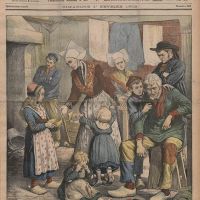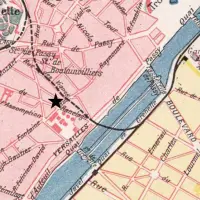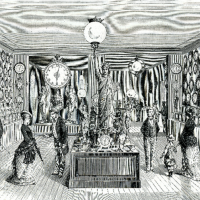“Dimanche soir – reçu lettre ce matin. Compte sur toi pour mercredi. Embrasse tous. Jean.” Sunday night – received letter this morning. [I] count on you [to come] on Wednesday. Love to all, Jean. The date on the postmark is June 13, 1904.
The message is written on the picture side of a postcard that we found in the stamp and card market in the gardens just off the Champs-Elysées. The photograph showed a huge building we didn’t recognize, with the words Dufayel on an elaborate clock tower topped with a dome which was further topped with a spire. Printed on the card are the words “Vue panoramique prise de la Butte Montmartre – P.P.C. – Paris.” (Panoramic view from the Montmartre Hill. P.P.C. might mean “picture post card.”)
Dufayel? Apparently it was a huge department store that sold furniture and housewares. When it opened in 1856, it was called Le Grand Magasin des Nouveautés. When the original owner died in 1888, an ambitious employee called Georges Dufayel bought it and gave it his own name.
Dufayel (1855 -1916) was quite an operator. He either invented or popularized the notion of buying goods on the installment plan and buying from a catalogue. He also sold coupons that could be used in other stores, and took a cut of each transaction.*
Les Grands Magasins Dufayel expanded over the years until the store occupied most of a city block to the east of the hill of Montmartre – about a hectare in all. The inside was palatial, with chandeliers and mirrors, and contained a winter garden and a theatre that seated 3,000. On top of the dome was a revolving searchlight of 10 million candlepower – roughly similar to the light that currently revolves on top of the Eiffel Tower. The statues on either side of the entrance represent “Credit” and “Publicity” and over the door is “Progress” riding in a chariot. (For pictures of the interior, click here or here.)
The building is only one of the points of interest in the photo. There is a tall chimney on the right, and a sort of crane on the left. In front is a lively street scene, with people coming and going to and from small, awning-shaded shops. The area is not fully developed, since “Terrain à Vendre” (land for sale) is painted on one of the walls in the foreground.
Curious to see what was there now, we set off with a friend on a fine May morning to find out. We located the building shortly after leaving the Barbès-Rochechouart Metro station. We approached its southern front first, which was also impressive, before we found the west-facing façade shown on the postcard. The building is now occupied by the BNP Paribas bank.
Alas, what was once the front entrance is now the back of the building and is obscured by an ugly fence. The squared-off dome was gone, and so is the huge clock face, but the stonework with its relief sculpture of Progress riding in a chariot is still there.
We wondered if the view from the Butte Montmartre would still show the street in front (rue André del Sarte). We climbed the steps at the end of the street and headed into the Louise Michel park to take a look.
At first we took the lower path, where thick trees and bushes prevented us from getting a clear sight of the building.
But when we took a closer look at the postcard, we realized that since the lower path was visible at the bottom left, the picture had been taken from much higher up.
Eventually, on one of the upper paths, we found a bridge over what must have been a small creek or gully that gave the same view as the postcard, although trees still obscured part of the view.
The land that was for sale at the turn of the century had been sold. The chimney and the crane were gone. But the street still contained small shops and cafés, and people were still coming and going.
What about the other side of the postcard? Who was Jean expecting on Wednesday? The card arrived on the same day it was sent (the Monday). Who needed e-mail in those days of same-day mail service?
The postcard was addressed to “Mademoiselle Lucienne Ricard, 18 rue Nicolas-Simon, Tours, Indre-et-Loire.” Rue Nicolas Simon does not appear on Google maps, but I found it on an image of an old Baedeker map of Tours. When I compared it to the current map, I realized that the street had been renamed rue Jules Simon. No. 18 is still there, visible in Street View.
Jean must have known Lucienne well, because he used the intimate “tu” form of address. I wonder if they were brother and sister. And, if Jean’s last name was Ricard, whether he was the novelist of that name who published several books in the 1920s and 1930s.
I hope Lucienne made the rendez-vous in Paris with Jean. Perhaps they shopped at Dufayel, entering the palace of commerce by the grand doors under the clock tower.
Text by Philippa Campsie, photographs by Philippa Campsie and Norman Ball.
*Dufayel also bought a house at 76, avenue des Champs-Elysées, which had once belonged to a duchess, tore it down, and had the architect who had designed his store (Gustave Rives) create an even more elaborate mansion (now demolished). He installed himself there in 1905 or so with his art collection. His name is also associated with Sainte-Adresse in Haute-Normandie, where there is another large building bearing his name. He created a resort area in the town known as “Nice – Havrais” (the Nice of the area of Le Havre). Busy guy.





























Simply stunning and brilliant tracking….kudos to you both.
Great detective work – very interesting. However, it does throw up one or two other questions;
– what is the stone tower to the right?
– what is the iron framed tower behind?
We’ll see what we can find out, and if you have a chance to do some digging too, that would be great.
What a wonderful piece of serendipity – a magical way into a lost piece of Paris, and the enigmatic postcard raises so many romantic possibilities!
I wonder, was it common to write on the front of postcards like this?
Yes, writing on the front of the postcard was common, and many postcards were designed with extra space on the front for writing messages. As you can see from the back of this one, there was no space provided there for messages.
Interesting, thanks for the reply.
I’ve mentioned this post in my weekly round up of good stuff on my blog – cultureandstuff.com. I’ll definitely be following this blog closely in future, it’s right up my boulevard.
Dear Peter,
Thank you so much for the write-up, and for letting us know about your fascinating blog. We will post a link to it on our site. If this were not a workday, we would read all the entries at once, since they deal with just the sort of things that we love — Paris history and its odd byways, in particular. We look forward to further postings from you, and further exchanges on our favourite subject.
Philippa and Norman
Pingback: The Paris Blog: Paris, France Expat Tips & Resources »Blog Archive » A Parisian Dept. Store 100 Years Ago
Pingback: History Carnival time! « Madame Guillotine
Pingback: Seduced by the chimneypots of Paris | Parisian Fields
Fabulous research. I have just begun reading your blog and it is quite wonderful.
Pingback: One address, many stories | Parisian Fields
Pingback: Merry Christmas and don’t forget the bûche de béton | Parisian Fields
Pingback: How I learned to stop worrying and love Wikipedia | Parisian Fields
Pingback: Georges Dufayel – a Model Modern Retailer « French News Online Newsroom
Pingback: Le Bazar de l’Hotel de Ville | Parisian Fields
Pingback: In Search of Lost Time | Parisian Fields
Pingback: On reaching 100 – blogs, that is | Parisian Fields
I’ve just returned from a tour to Normandy and Paris with a group from my church led by our former pastor, E. Carver McGriff – a D-Day veteran who was wounded and later stationed in the Magasin Dufayel in the spring of 1945. He writes of his stay in the Dufayel in his book “Making Sense of Normandy” (published by Inkwater Press [inkwaterpress.com). I can’t find much information on the department store between Mr. Dufayel’s death and 1945 and am hoping you can direct me to such information.
Thank you for your assistance.
Sincerely,
Nancy Papas
pwnanc@gmail.com
I am delighted to hear from you and to learn a bit more about the building. I do know that the store remained in operation for another decade and a half after Dufayel’s death and closed in 1930, but I am not sure what became of it after that. At some point in the 1970s or 1980s, I believe, it was converted to apartments and offices (the Paribas bank occupies much of the office space), and the ground floor around the perimeter is now occupied by various shops. A couple of years ago, I talked my way into the courtyard and took a few photographs. The courtyard must have been carved out of the space where that wonderful staircase once stood. I am fascinated to learn that it was used to billet soldiers after the Liberation. I must read the book you mention, and thank you for letting me know about it.
And I realize that I should add the detail about the date of the store’s closing to the Wikipedia article I wrote on Dufayel.
Do let me know if you have other questions. I have quite a large research file on Dufayel.
Philippa Campsie
Hi there!
Today I bought some old postcards at the flea market in Montmartre and out of curiosity I googled the name of the addressee. Looks like Jean (or J.R. Like he signed on my postcard) and Lucienne continued their correspondense, my card is dated 13.12.06
The design is hylerious, that’s why I bought it. I haven’t completely figured out what it says yet, but it seems equally hylerious (“petit chat, gros comme le cheval de Tom-pouce”). I’d love to share it with you.
Rosanna
What fun! Do let me know more about what you find out. If you’d like to send an image to parisianfields@gmail.com, I’d be delighted!
Philippa
Pingback: Hark the Herald | Parisian Fields
What a fascinating bit of detective work. Thanks ever so much for putting this up. I was scrabbling around for info on the Dufayel department store a while back and this is one of the websites I was drawn to. Oddly enough, I happen own a piece of Dufayel memorabilia myself – although not, I hasten to add, any of the bricks and mortar! I own a rather impressive poster for the store which shows the huge building in all it’s glory. I would date it as being from the turn of the century, so early 1900s. Can’t say I’ve come across another but seeing how successful the store was, they must be out there somewhere!
You are right — there are many out there. Dufayel had a publicity business as well as the store, and plastered posters everywhere. You can see them in quite a few of Eugene Atget’s photographs and those of his contemporaries. Every time I see one in a postcard, I snap it up.
I have assembled quite a lot of information about Georges Dufayel, his department store, and Gustave Rives (the architect involved, who was Dufayel’s closest friend and heir, since Dufayel had no family of his own) and put together Wikipedia articles about both of them. One day I hope to write more about all of this.
Philippa
Just did a Dufayel poster search and saw some nice examples…but mine isn’t there! The search continues!!
Pingback: In a Pinch – BLDGBLOG
Pingback: Discovery in a dairy shed | Parisian Fields
Pingback: A city street, a lamppost | Parisian Fields
Thank you for for the interesting story! Do you perhaps know the name of the artist who created the excellent sculptures on the Dufayel building?
I will try to find out for you.
Philippa
Pingback: Postcards: Little windows into a vanished Paris | Parisian Fields